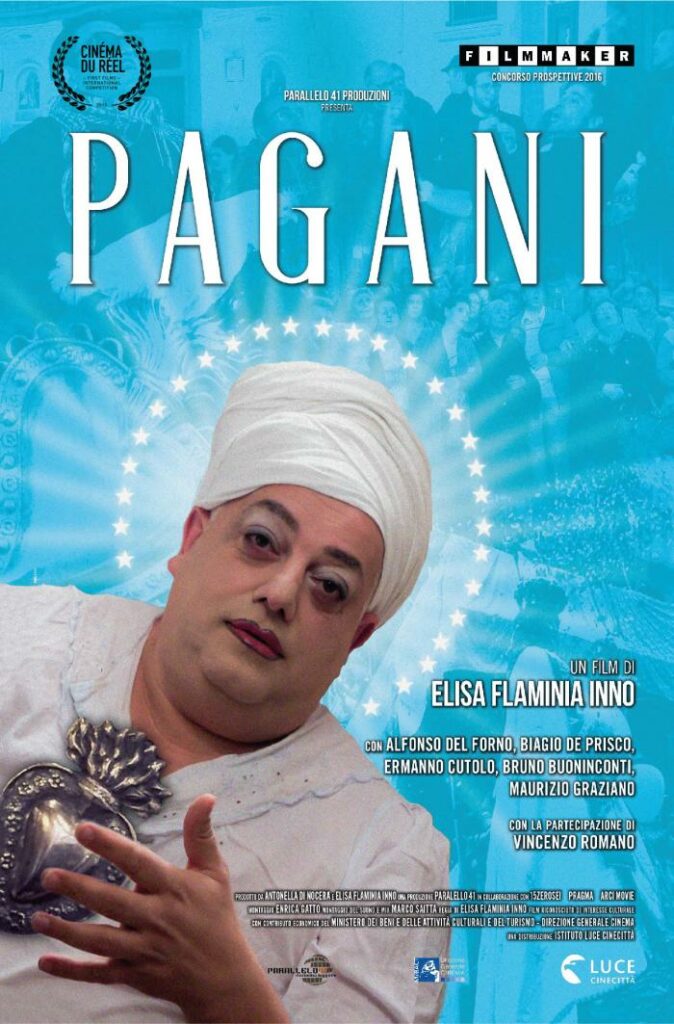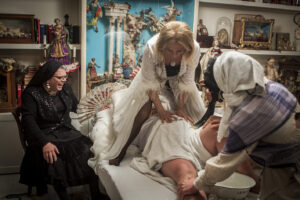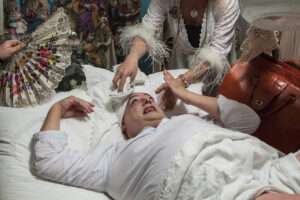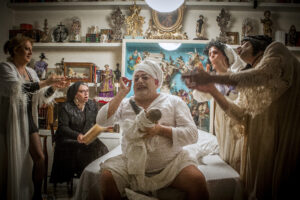Pagani

Country: Italy
Language: Italian
Year: 2016
Duration: 52′
Director: Elisa Flaminia Inno
Photography: Elisa Flaminia Inno, Mattia Colombo
With: Alfonso Del Forno, Biagio De Prisco, Ermanno Cutolo, Bruno Buoninconti, Maurizio Graziano
With the participation of: Vincenzo Romano
Editing: Enrica Gatto
Sound editing: Marco Saitta
Color correction: Simona Infante
Texts and research: Gerardo Sinatore
Production: Parallelo 41 produzioni
In collaboration with: 15|06 film
With the support of: MIC – Ministry of Cultural Heritage, Tax Credit, Lazio Region
Produced by: Antonella Di Nocera and Elisa Flaminia Inno
Distributed by: Istituto Luce – Cinecittà; CNC – Center national du cinema et de l’image animée, UniversCiné.be
Online distribution: Chili.tv, Tenk
Images en bibliothèques Paris (France)
Film supported by the Commission nationale de sélection des médiathèques
Sinopsis
In the deep south of Italy, ancient religious syncretisms linked to Mother Earth survive. In Pagani, near Pompeii, seven days after Easter the Madonna delle Galline is celebrated, a Virgin venerated with ancestral songs and dances. For thirty days the devout people move in unison to perpetuate the Tradition, an event in which everyone participates, animated by a faith that becomes memory and transcendence. Fonzino is the chosen one who leads the people in the construction of the Tosello, a secret temple that represents the present every year, revealed to the people when the Virgin passes by on the day of the feast. Biagino is a farmer, a singer and part of a group of effeminate devotees, protagonists of the most orthodox liturgical events and bearers of customs linked to the homosexual world such as the marriage of the Zeza, the Death of Carnival and the Figliata dei Femminielli. The wait for the Madonna marks the days preceding the feast and the repetition of popular rites that mark the passage of the seasons. Until the day of the Madonna delle Galline, when everything melts into a riot of music and dance aimed at catharsis and the birth of a new spring.
The Spring Equinox is one of the two moments of the year in which day and night are in perfect balance. In previous centuries it was linked to the Jewish Easter, which was celebrated on the night of the first full moon of spring. In this space-time, celebrations were held in honor of pre-Christian deities to whom people offered dances, hymns, music, libations and the best fruits of the earth. The dances and songs were prayers and celebrated the miracle of spring, invoking its perpetuation with a practice today called drum dancing or tammurriata, and were carried out with movements of encounter and falling in love that sometimes resulted in enchantment. These customs were very similar to those practiced in honor of the Great Mother – who became by syncretism over time Astarte, Cybele (brought to Titoma by the sea on April 4, 204 BC according to Titus Livius), Ceres, Demeter, Juno and then Mary Most Holy, Virgin and Mother of Christ. The Magna Mater was the goddess of the pagans and represented the Earth, fertility and regeneration of the world, in a metaphysical link between human sexuality and plant fertility. Many trace the tammurriata back to the cults in honor of Demeter – invoked in the Homeric Hymns as the “bringer of seasons”. The rituals dedicated to her are better known as the Eleusinian Mysteries, where song and dance became prayer thanks to the use of a drum, depicted in the archaeological finds visible in the excavations of Pompeii and Herculaneum.
The goddesses assured the faithful of health and prosperity in this life and the prospect of salvation in the afterlife through rites. The devotee had to consume a traditional meal, enter a room reserved for the ritual (such as the Tosello), see the sacred symbols and receive the revelation: the truth about what the world is, where we come from and where we are going. The cycle of mysteries began in February with the Small Mysteries (such as the rite of Candelora in Montevergine) until September (Great Mysteries) and began with the pilgrimage of the Ephebes to Eleusis (just as it helps her in Montevergine). The Phrygian mysteries began in spring with two processions to the temple of Cybele, the second (March 22), the most important, consisted of carrying in the procession a pine tree cut down and cleaned of branches, wrapped in red woollen bandages and decorated with flowers and musical instruments. The ceremony was called Arbor Intrat and some sources report that over time the pines were replaced by palms and renamed, with the coming of Christ, Palm Sunday. On March 25, called Hilaria, meaning Joy (the period of the year in which the Madonna delle Galline is celebrated), the symbolic rebirth of the god Attis was celebrated (the shepherd boy loved by Cybele who betrayed her and out of fear castrated himself with his own hands, bleeding to death) and the joyful affirmation of spring (later renamed Easter by the Christian-Catholics). The cycle closed with dances and songs and the statue of Cybele returned to the temple.
The priests of Cybele – also called galli or corybantes – during the rite sometimes self-harmed to the point of castrating themselves to ensure their devotion to the Great Mother, with prayers, screams and dances with obsessive rhythms and mystical exaltation. Castration also meant wanting to resemble her and thus acquire a superior power. These priests were attributed the power to interpret dreams and to divine through chickens, through the flight of birds and the movement of the stars. The eunuch priests wore women’s clothing which in most shamanic cultures attribute a sacred value to men who dress up or pose as women: this closely links shamanic powers, ritual castration and homosexuality.
Trailer
Director’s Notes
The idea of making this film was born from a research path in the popular traditions of southern Italy, from the desire to tell the story of the transformation of an ancient religiosity that is still expressed today through ritualized expressions. In the Tradition in Campania, the uses and customs of the ancient world live on, intertwined in a symbolism that links human life to natural elements and is expressed through contemporary forms of devotion. What is perceived today as spectacular – popular dances, trance and community as a reason for living – is the symbol of a very strong belonging to a place, of resistance to modern individualism and of a collective identity that in Campania survives protected by the mystery of faith. The celebration of the Mother as a guarantee of new life, the cult of the dead and the interaction with natural and supernatural forces frighten contemporary man, now disabled from relating spiritually and materially with his own nature. In the age of mass communication, the traits of a culture passed down orally are grafted by religious, social and communicative syncretisms in continuous metamorphosis. In this time it was necessary to tear apart reality with the eye of the camera, an internal and participatory eye, which opens a passage on the history of a south bearer of hidden immaterial treasures.
The film takes place in the areas on the outskirts of Pompeii, where after years of participation in devotional and ritual events I chose a story and protagonists. Fonzino with the construction of the Tosello Madre, constitutes the backbone of the narrative structure. The Tosello is ara pacis – an ancient place of worship and aggregation where misery is exorcised and the Mother is invoked – as the sun was invoked by beating the Diana, or by playing the tammorra.
Biagino embodies Tradition, he is the bearer of ancient knowledge of Vesuvian rural life that he keeps alive together with the elderly women. Together with Ermanno, Bruno and Maurizio they are part of a gay community of devotees that reveals the figure of the femminiello – a superior being close to the primordial human condition of the androgynous. Masters of worship, virtuosos in song and dance, they are endowed with a powerful faith capable of sustaining this particular destiny.
PAGANI is the story of this community in the period preceding the celebration of the Madonna delle Galline, the most lively cult among the Madonnas of Campania, a feast celebrated seven days after the spring equinox.
“I ate from the tympanum, I drank from the cymbal, I carried the lamp, I entered the bridal chamber” (Eleusinian Mysteries, formula of an initiatory rite)
Scene photos
Press
Partecipatios
Filmmaker International Festival – Milano
Cinéma du Réel International Festival – Parigi
Terre di Cinema – Festival du nouveau cinéma italien – Paris
Cinéma La Clef – Parigi
Cinema Corse – Corsica
Cinema La Fenice – Pagani
Rassegna Astradoc – Viaggio nel Cinema del Reale – Napoli
Rassegna Incontri dal vero – Roma
Lovers Film Festival – Torino
Etnofilmfest – Monselice
Rassegna Cinema intorno al Vesuvio – Napoli
Cinema Melies – Port-de Bouc Marsiglia
Films Femmes Méditerranée – Marsiglia
Rassegna Immagini dal Sud del Mondo – Viterbo
Rencontres Autour du Film Ethnographique – Grenoble
Rassegna Nostalgia del Futuro – Napoli
Istituto di Cultura italiana – Montreal
INIS – Institut national de l’image et du son – Montreal
ItalianDoc, London University
Salento Rainbow Film Fest – Lecce
Masterdoc Film Festival – Los Angeles
Cinema del Reale – Lecce
Centre culturel franco-italien – Nantes
Divergenti festival internazionale di cinema trans – Bologna
Etnofilmfest – Monselice (PD)
Festa di Cinema del Reale – Specchia (LE)
Rencontres Autour du Film Ethnographique – Montpellier
MAV – Materiali di Antropologia Visiva – Istituto Centrale per il Patrimonio Immateriale – Roma
Italian DOC Season – University College – Londra
Disorder Festival – Eboli (SA)
Festival Everybody’s Perfect – Ginevra
Università degli Studi di Roma “La Sapienza”
Exeter Phoenix Art Centre – Exeter
Ciao Moka Festival – Marsiglia
Cinematopedia – Napoli
Fanatici Festival – Napoli
Cinema Bìo – Genève
Pisciott’Arte – Pisciotta (Sa)
Awards
Best Religious Film at Masterdoc Film Festival – Los Angeles
PITCHING FORUM
Docs for sale – IDFA – Amsterdam
Italian Doc Screenings – Bari






